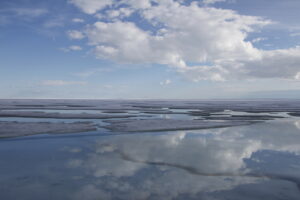
People & Culture
On thin ice: Who “owns” the Arctic?
As the climate heats up, so do talks over land ownership in the Arctic. What does Canadian Arctic Sovereignty look like as the ice melts?
- 4353 words
- 18 minutes
This article is over 5 years old and may contain outdated information.
Mapping

The mysteries of the Arctic have captivated explorers and mapmakers for centuries, as Europeans searched for northern sea routes to Asia.
The blending of myth and fact in the maps below represent our evolving understanding of the Arctic.

1. Mercator, 1595
This map, drawn by Flemish cartographer Mercator, was among the first to indicate an all-water route across the top of North America. An enormous magnetic rock encircled by four islands forms the North Pole. At the time, many people believed that the waters between the islands flowed northward into the centre of the Earth.

2. Barentsz, 1599
This 1599 map by Dutch navigator Willem Barentsz shows Spitsbergen — the main island in Norway’s Svalbard archipelago — mapped for the first time. Labelled as Het Nieuwe Land, meaning “the new land” in Dutch, the Arctic island had been forgotten since its discovery by the Vikings 400 years prior to Barentsz’s arrival. The Barents Sea north of Norway and Russia was named after the explorer.

3. Pitt, 1680
Published in the English Atlas by Moses Pitt, this North Pole map shows northern Canada in more detail than the first two — but a lot is still missing. Everything west of Baffin’s Bay and Hudson’s Bay was still unknown to the European explorers. Notice the depictions of Inuit culture and whaling along the top of the map, as well as the inset of Nova Zembla. Explorers took interest in the Russian island while searching for the Northeast Passage.

4. Scherer, 1702
Heinrich Scherer, a Jesuit cartographer from Germany, held on to the hope of a Northwest Passage via Hudson’s Bay, though there had not been any major expeditions to the Canadian Arctic since the 1630s to provide more detail. His decorative map included the mythical island, Frisland.

5. de Wit, 1715
Large areas remain blank in this 1715 map by Dutch cartographer Frederick de Wit, which is decorated with scenes from the whaling industry.

6. Vaugondy & Diderot, 1772
The French Robert de Vaugondy family of mapmakers prepared this map of northwestern North America in 1772 as a supplement to Diderot’s Encyclopédie. The map depicts a mythical Northwest Passage.

7. Thomson, 1814
Scottish cartographer John Thomson removed the possibility of a Northwest Passage from his 1814 map of the northern hemisphere. The hand-coloured map shows immense political and geographical detail around the hemisphere, with the exception of the Canadian Arctic. Notice how the Thomson has placed emphasis on detail and accuracy rather than the decorative elements of earlier maps.

8. Parry, 1820
Arctic explorer William Parry‘s 1820 map shows the route his expedition took in the quest to find a Northwest Passage. The expedition reached as far as Melville Island (shown on the left of the map), where the crew was iced in for 10 months. The Parry Channel, a natural waterway through the Canadian Arctic, was named for Parry.

9. Riou, 1866
This 1866 map of northern Canada and Greenland was published by the French author Jules Verne in his novel Journeys and Adventures of Captain Hatteras. Known as a father of the science fiction genre, Verne is best known for his novels Around the World in Eighty Days and Twenty Thousand Leagues Under the Sea.

10. Stanford, 1876
Edward Stanford’s 1876 circumpolar map shows a well-defined Arctic coastline. The English cartographer and businessman coloured known sea ice light blue. He left the unexplored areas white. By 1880, the British government had given up on the hope of using the Northwest Passage as a shipping route and transferred sovereignty of the Arctic islands to Canada.
Is there a map you think we should feature? Tweet us!
Are you passionate about Canadian geography?
You can support Canadian Geographic in 3 ways:

People & Culture
As the climate heats up, so do talks over land ownership in the Arctic. What does Canadian Arctic Sovereignty look like as the ice melts?

Environment
The uncertainty and change that's currently disrupting the region dominated the annual meeting's agenda

Mapping
Maps have long played a critical role in video games, whether as the main user interface, a reference guide, or both. As games become more sophisticated, so too does the cartography that underpins them.

Environment
Warming trends continue due to human-caused climate change